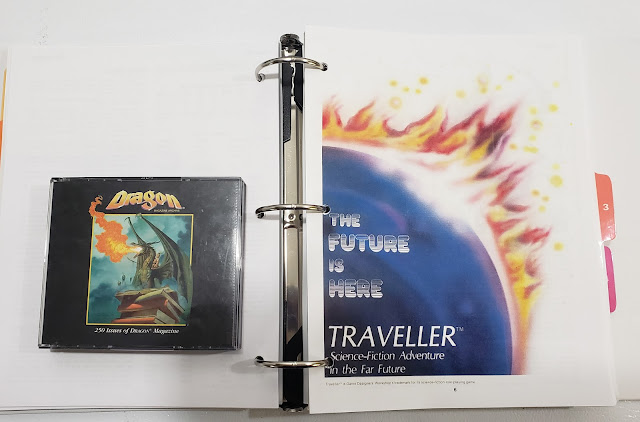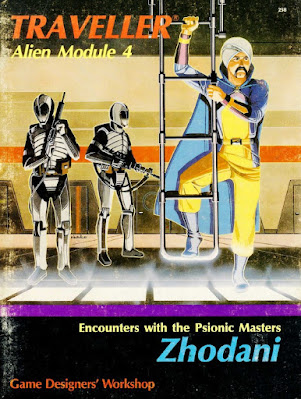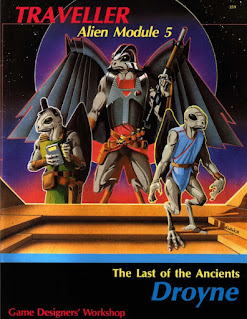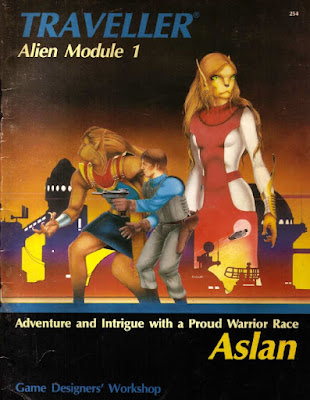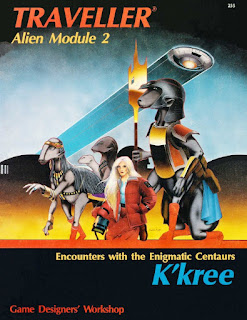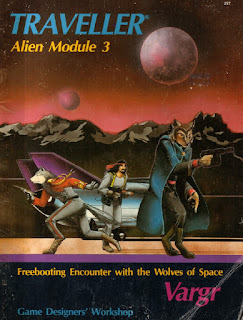
Far to the north of the continent of Ghelspad lies the frozen lands of Fenrilik, accessible just once per year. Its separation means that in comparison it was little touched by the Titanswar which beset the southern continents of Scarn, but refugees from the Divine War made their way north in its aftermath and continued trade between Ghelspad and Fenrilik means that certain practices have been imported, but not widely spread. The indigenous peoples of the frozen north, primarily the ice fey called the Eschek, are tribal, worship spirits rather than gods, rarely war with each other, and barter for goods and services rather trade away precious resources. Rent in two by the massive Torbor Gorge, the Roof of the World is not only dangerous due to the artic winds and temperature, ice and snow, there are many native species which are also highly dangerous to the unwary. These include the titanspawn known as Blood Gardners, whose haunting song lures victims into its clutches who are then kept alive to feed the Bloodfruit which the creature relies upon for survival; Frost Maidens, former Dryads whose trees were frozen and themselves turned into an icily undead version of its former self; and Crawling Glaciers, gargantuan oozes of solid ice which slowly scour the continent. There is another threat, as yet unknown, which lurks beneath the continent—the scorpion-men known as Skerrai, which surge up onto the surface to attack and capture victims they can implant with their larvae. Welcome to the Frostlands of Fenrilik.
Frostlands of Fenrilik is a supplement for use with
Dungeons & Dragons, Fifth Edition, which describes the northernmost continent on the world of Scarn, the setting for the
Scarred Lands setting published by
Onyx Path Publishing. Previously described in
Strange Lands: Lost Tribes of the Scarred Lands, this supplement is available via the
Slarecian Vault, the community content programme for the setting. It expands upon the history, geography, civilisations, and religions of Fenrilik, supported with rules for travel and survival in the arctic wastes, new races, subclasses, and spells, new monsters, and an introductory adventure designed for Player Characters of First to Third Level.
Frostlands of Fenrilik introduces the continent via the journal of Yenei Koneru, Vera-Tre researcher and adjunct of the Ganjus Vigil, who like the Player Characters has made the long, only once-a-year open journey to Fenrilik, first to continent’s ‘major’ port of Stasiam and from there to its only city of Kovokimru—and beyond. Yenei Koneru and her companions will also appear in the supplement’s scenario. It opens with descriptions and a table of Fenrilik’s weather, its major settlements, and tables for both encounters and environmental hazards. The latter in particular highlights how deadly Fenrilik actually is, from avalanches and thin ice to fissures and geothermal vents, whilst it is suggested that the encounters be used to imperil the Player Characters’ survival rather than being used as combat encounters. The culture and attitudes of Fenrilik’s tribes are described in quite broad detail, leaving the Dungeon Master to develop further specifics. If the opening chapter is missing something, it is a map of Fenrilik, although one is given at the end of Frostlands of Fenrilik. Unfortunately, the map is not all that interesting and should really have had a few more landmarks indicated.
Definitely detailed though, is the continent’s one city, Kovokimru. It receives a full chapter to itself compared to the thumbnail descriptions of the towns and villages detailed earlier. Mostly built using a mix of wood and the famed hardened icework of the Eschek over geothermal vents which keep the city warm, Kovokimru is inhabited by several tribes and includes a large market and trade hall, as well as a Mage’s Guild, which grew out of a personal lending library into a school and guild. Numerous NPCs and locations are described as well as the holidays and festivals which take place over the course of a year. The fact that Fenrilik is only accessible once a year means that the Player Characters will probably be spending that year in and around the city bas their base of operations, so these festivals are something that the Dungeon Master can develop plots and adventures around, helping to bring the setting further to life. This is in addition to the quartet of adventure seeds included at the end of the chapter, which although involving an entertaining range of combat, diplomatic, investigative, and magical challenges, will need a fair of development upon the part of the Dungeon Master. Three locations are also described and mapped—an inn, a tavern, and a flophouse. However, it is disappointing that no map of Kovokimru itself is provided.
One big cultural difference between Fenrilik and Ghelspad is the use of money. The tribes of Fenrilik value metal of its practical use rather than any monetary value. Consequently, any money the Player Characters arrive with will not be as valuable as it might be back home. Instead, they will find themselves bartering for goods and services—and being paid in kind! However, the peoples of Kovokimru accept most visitors as long as they contribute to city’s welfare, which can include menial jobs if anyone is down on his luck. Given how important this aspect of the city is, it is a pity that a few examples are not included in the supplement’s discussion of it. Nevertheless, this will force both the players and their characters to think differently when it comes trading and bartering, and the roleplaying possibilities that this lends itself to.
The other location described in detail in
Frostlands of Fenrilik is Tobor Gorge, which divides Fenrilik in two and is hundreds of miles long and a mile deep. It has only one crossing point opposite Kovokimru and only one easy means of getting down—a rickety lift-and-pully system, which you need to be hooked into lest you be blown into the gorge. Alternatively, it can be climbed down, but that is perilous. The sides of the cavern are doted with caverns, most of which have yet to be explored, leaving the Dungeon Master to detail them and turn them into adventure sites. There are a couple of adventure seeds, although these are not as inventive or as interesting as those for Kovokimru.
Frostlands of Fenrilik also adds a number of new character options and new spells. The Eschek, inaccurately described as ‘winter gnomes’ are actually creatures of ice renowned for crafting ice into tools, furniture, and buildings. Those few who travel beyond Fenrilik require a frost ring to enable to withstand the high temperatures of the south. The Krampek are satyr-like, but their horns are antenna actually used as part their communication, with a disarming appearance which often gives them an advantage when attacking first. They are highly suited to living underground and most of them are slaves of the dreaded Skerrai. The third new race is the oddest and the most recent to appear. They are Taslenh, again creatures of ice, but created when an ooze known as an ‘ice warden’ imprints on a humanoid. They remain both humanoid and ooze, so a bit odd!
Although there are no new Classes in
Frostlands of Fenrilik, it does detail four new sub-classes. These are the College of Hope for the Bard, who boosts morale and brings comfort across the frigid lands of the north; the Way of the Winter Soul as a Monk Tradition, who can direct cold or heat damage through his hands, become one with fog, steam, and snow, and so on; the Ice Walker Ranger Archetypes who can survive in the frozen north and even fashion arms and armour from ice; and the Ushada Marked is a Sorcerous Origin which draws from Fenrilik’s primal spirits. They also serve as spiritual leaders for some communities, often replacing Clerics, which opens up roleplaying possibilities for any Player Character. Overall, this a good mix of options.
Frostlands of Fenrilik includes a list of the spells used on the continent, and adds new ones too. Some have a cold theme, such as the
Cold Snap cantrip which casts cold deep into the victim’s bones and Ice Shards which creates shards that float around caster, which can be used as an Armour Class bonus or expended to shoot at opponents and do damage. Particularly cruel are the
Fracture and
Rupture spells, the former snapping one of a target’s bones, the latter fracturing his skull. Most of the spells have been crafted by the Titans. For example, in response to an attack by his fellow Titans, Golthain the Faceless crafted
Empathy of the Faceless One to ensure that his attackers felt the same damage they inflicted upon him. A Bard and Druid spell, it affects five attackers and if any are reduced to zero Hit Points or are killed, this rebounds on the caster as his player has to making saving throws to avoid being stunned for a Round. The spells are a good strong mix of interesting theme and flavour, though of course, specific to the Fenrilik and the Scarred Lands setting.
The bestiary, ‘Creatures of Fenrilik’, adds monsters particular to the frozen continent and its frigid environs. There is a slight predilection for the gargantuan in the dozen or so given, such as the aforementioned Crawling Glacier; the Fell Deer, great shaggy beasts whose tusk-like antlers curve down and are used to break up the tundra to get at the lichen and moss it feeds on, and which are used as beasts of burden, travel, and rarely war; and the Gelidiceph—an ice kraken! Perhaps more an immediate threat is the scorpionmen-like Skerrai, who may or may not be the artic version of the Sandmaskers from the far southern deserts, and who lurk in the tunnels beneath Fenrilik, allegedly for something… Even the immature Skerrai are deadly, perhaps too deadly for low-Level Player Characters and the Dungeon Master may want to use them with care lest they overwhelm her players and their characters. Their desire to implant their larvae in their victims adds an element of horror to any encounters with them. Also included here is the Ice Warden, flowing globs of dark blue water which imprints itself on hosts and creates the new player Race, the Taslenh.
Rounding out
Frostlands of Fenrilik is ‘Into the Gorge’, a short introductory which takes the Player Characters into the caverns found in the wall of Tobor Gorge. It starts with them on the way to Kovokimru where they are offered employment—a matter of a certain missing anthropologist, one Yenei Koneru. Another job sees them explore some of the caverns in Tobor Gorge. Could the two be connected? This is primarily an exploration scenario in which the Player Characters will discover some of the secrets that lie below Fenrilik and encounter some of its strange inhabitants. Player Characters who rush in first, leaving questions for later, will be at a disadvantage and will likely have to do much to make up for earlier mistakes. However, their style of play will be rewarded with some tough—perhaps too tough—challenges towards the end of the scenario. Potentially, ‘Into the Gorge’ is a challenging scenario for First Level Player Characters, so the Dungeon Master may want to make some adjustments, but otherwise, the scenario does a decent job of introducing the setting and some of its secrets.
Physically,
Frostlands of Fenrilik is generally well written and well presented. The artwork varies in style and quality, but some of it is very good. The maps though, are disappointingly bland, and again, the city of Kovokimru could have done with a map.
One aspect of Fenrilik that the supplement does not explore fully is that of survival and travel. Although the table for weather, encounters, and environmental hazards are useful, but there is no advice how travel is handled, important given that many of the tribes of Fenrilik are nomadic and that the Player Characters will definitely have to travel from Stasiam to Kovokimru. Some survival rules would have been useful.
Frostlands of Fenrilik does have some minor issues, but there is a lot to like in its pages. There are fearsome monsters and some nicely detailed locations in both Kovokimru and Tobor Gorge for the Dungeon Master; challenges for the players and their characters in terms of survival and interacting with the indigenous peoples, let alone those monsters; and then also for the players, there are interesting new subclass options and spells (which can also be used by NPCs to, of course). With a time limited means of access,
Frostlands of Fenrilik is an excellent introduction to the continent of Fenrilik and a one-year campaign set in the frozen north.
 Conall Yellowclaw is on an urgent quest. The son of King Erin has been kidnapped and the king laid the blame firmly on Conall’s three adult children and locked them up in the royal dungeons. King Erin has also granted one chance to prove their innocence and buy their freedom: venture beyond the kingdom’s borders and acquire the famed brown horse belonging to the mysterious King Lochlann. Now he has heard of this King Lochlann—and hopes that most, if not all of the terrible stories he has heard about him are untrue, but he has no idea where he can be found and certainly no idea that he even had a horse—brown or otherwise. Worse, Conall is just a simple tenant farmer, getting on a bit and probably past the age when he should be going off on adventures—even if it is to fulfil a quest given to him by his king. Fortunately, he is persuasive and he is pretty sure that he can talk someone, or rather more than someone, preferably a party of younger, more capable adventurers, into accompanying him and fulfilling the quest on behalf of King Erin. Since time is short, he approaches them directly and asks for the Player Characters’ help.
Conall Yellowclaw is on an urgent quest. The son of King Erin has been kidnapped and the king laid the blame firmly on Conall’s three adult children and locked them up in the royal dungeons. King Erin has also granted one chance to prove their innocence and buy their freedom: venture beyond the kingdom’s borders and acquire the famed brown horse belonging to the mysterious King Lochlann. Now he has heard of this King Lochlann—and hopes that most, if not all of the terrible stories he has heard about him are untrue, but he has no idea where he can be found and certainly no idea that he even had a horse—brown or otherwise. Worse, Conall is just a simple tenant farmer, getting on a bit and probably past the age when he should be going off on adventures—even if it is to fulfil a quest given to him by his king. Fortunately, he is persuasive and he is pretty sure that he can talk someone, or rather more than someone, preferably a party of younger, more capable adventurers, into accompanying him and fulfilling the quest on behalf of King Erin. Since time is short, he approaches them directly and asks for the Player Characters’ help.



